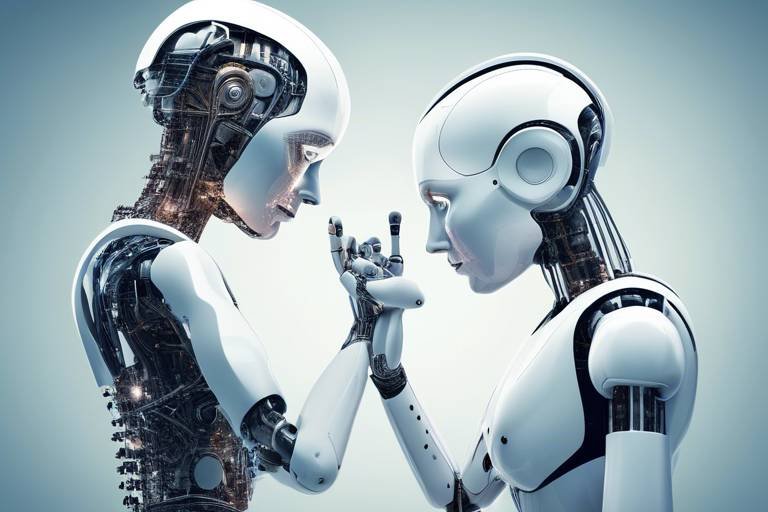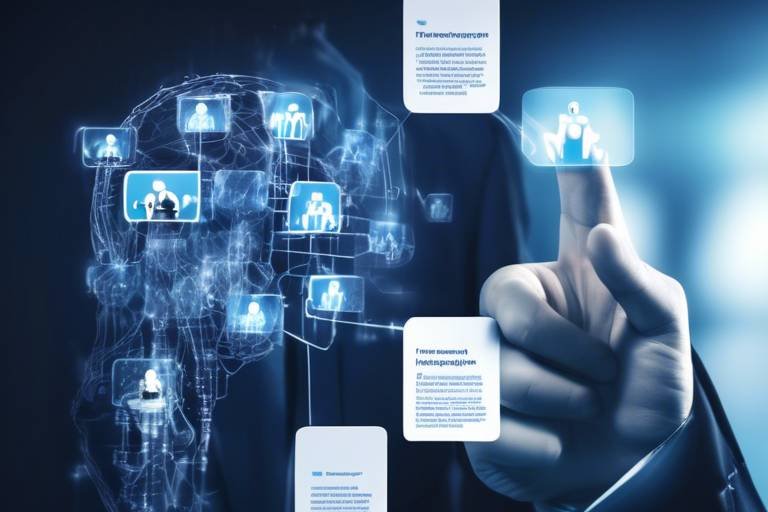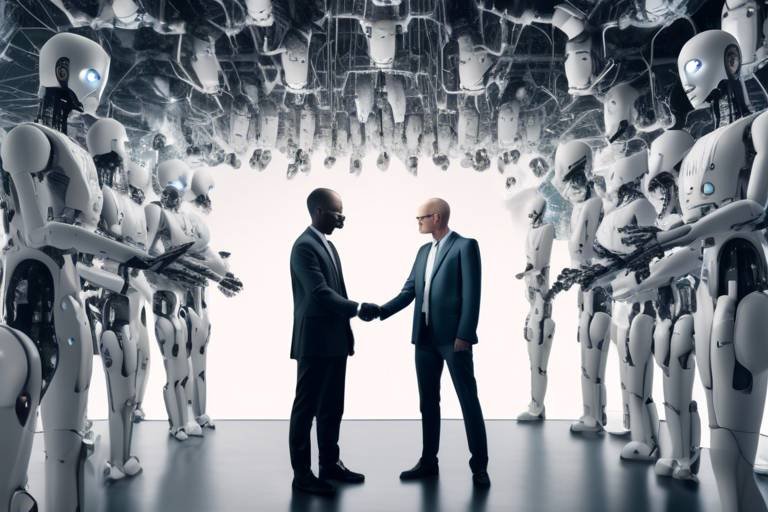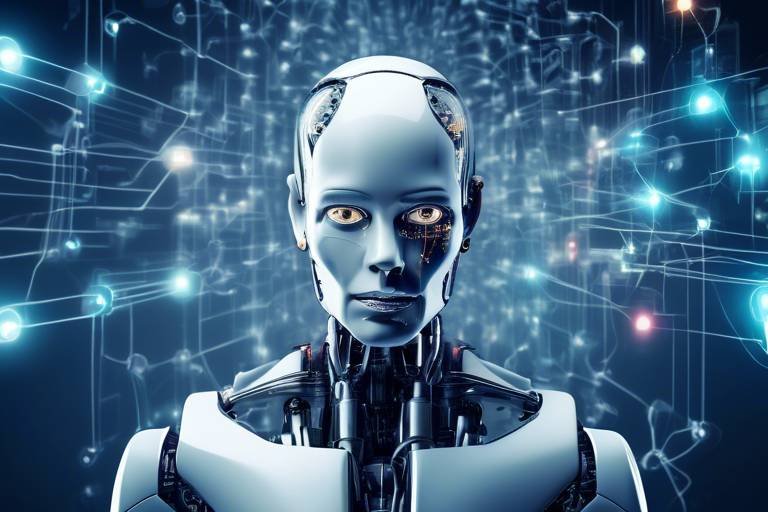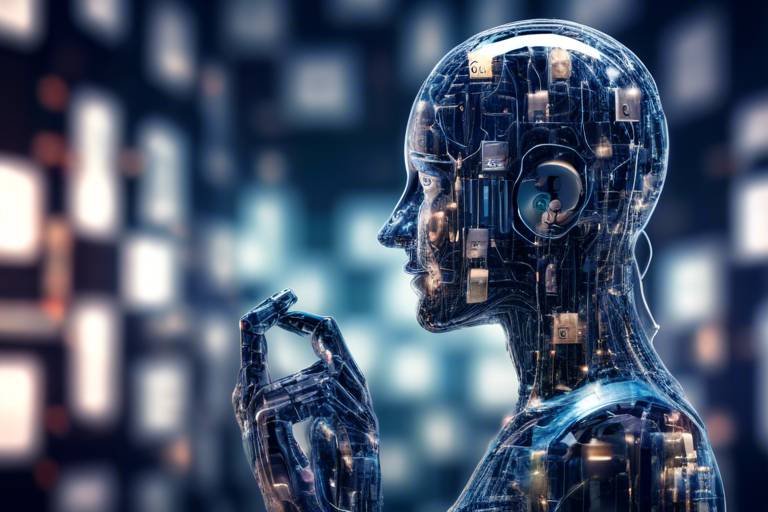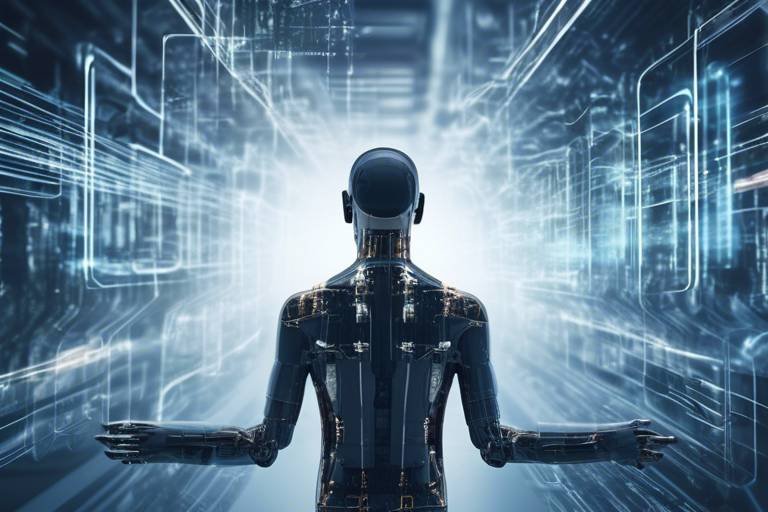Revolutionizing Workspace Collaboration with AI
In today's fast-paced business environment, the way we collaborate in the workplace is undergoing a dramatic transformation, thanks to artificial intelligence (AI). Imagine a world where your team can communicate seamlessly, projects are managed effortlessly, and decision-making is supported by data-driven insights. This is not just a dream; it’s becoming a reality as AI technologies are integrated into our daily work processes. By leveraging AI, organizations are discovering new ways to enhance productivity, streamline communication, and foster a more engaged workforce. So, how exactly is AI revolutionizing workspace collaboration? Let's dive into the exciting world of AI-driven tools and strategies that are reshaping the modern workplace.
AI tools are reshaping how teams communicate, enabling real-time collaboration and reducing barriers that previously hindered effective teamwork. Traditional communication methods often lead to misunderstandings and delays, but AI-driven platforms are changing the game. For instance, tools like chatbots and virtual assistants are now commonplace in workplaces, providing instant answers to queries and facilitating smooth interactions among team members. These platforms can analyze conversation patterns and suggest the best ways to communicate, ensuring that everyone is on the same page.
Furthermore, AI can help in identifying the most effective times for team meetings by analyzing calendars and availability, effectively eliminating the back-and-forth emails that can waste precious time. This not only enhances communication but also boosts morale, as team members feel more connected and engaged. With AI, teams can collaborate in ways that were previously unimaginable, breaking down geographical barriers and promoting a culture of inclusivity.
One of the most significant impacts of AI in the workplace is its ability to enhance productivity. By automating mundane and repetitive tasks, AI frees up employees to focus on more strategic activities that require human creativity and insight. Imagine spending less time on administrative duties and more time brainstorming innovative ideas or developing new strategies. This shift is not just a fantasy; it’s happening right now in organizations that embrace AI technologies.
Project management software infused with AI is revolutionizing the way teams track progress and allocate resources. These advanced tools analyze project data in real-time, providing insights that help managers make informed decisions quickly. For example, AI can identify potential bottlenecks in a project timeline and suggest adjustments to keep everything on track. This proactive approach to project management minimizes delays and ensures that teams can deliver results efficiently.
Utilizing predictive analytics, AI can forecast project outcomes and timelines, aiding in better planning. By analyzing historical data and trends, AI tools can provide valuable insights into potential risks and opportunities. This foresight enables teams to strategize effectively and allocate resources where they are needed most, resulting in improved project success rates. Organizations that leverage predictive analytics are setting themselves up for success in an increasingly competitive landscape.
AI can automatically assign tasks based on team members' strengths and availability, optimizing workload distribution. This means that the right person is always matched with the right task, leading to higher quality outcomes and increased job satisfaction. Imagine a scenario where you no longer have to manually delegate tasks or worry about whether someone is overloaded—AI takes care of this for you, allowing for a more harmonious work environment.
AI assists leaders in making data-driven decisions by providing insights and analysis. In collaborative environments, where decisions often involve multiple stakeholders, AI can synthesize vast amounts of information quickly and accurately. This capability allows leaders to focus on strategic thinking rather than getting bogged down by data analysis. With AI, decision-making becomes more efficient, informed, and ultimately, more effective.
The rise of remote work has led to an increased demand for virtual collaboration tools powered by AI. These platforms facilitate teamwork and engagement among distributed teams, making it possible to collaborate as if everyone were in the same room. AI enhances the remote work experience by providing tools that foster engagement and collaboration, such as virtual meeting rooms equipped with real-time translation and transcription services.
AI technologies enhance the remote work experience by fostering engagement and collaboration among distributed teams. For instance, virtual whiteboards and brainstorming tools allow team members to contribute ideas in real-time, regardless of their location. This not only makes meetings more interactive but also ensures that every voice is heard, promoting a culture of inclusivity.
Integrating AI capabilities into existing collaboration tools can maximize their effectiveness. Many organizations already use platforms like Slack, Microsoft Teams, and Asana, and by adding AI functionalities, these tools become even more powerful. For example, integrating an AI-driven analytics tool with your project management software can provide insights that help teams optimize their performance and achieve their goals more effectively.
- How does AI improve team communication? AI enhances communication by providing real-time insights, automating responses, and suggesting optimal communication methods.
- Can AI tools really increase productivity? Yes, by automating repetitive tasks, AI allows employees to focus on more strategic work, thereby increasing overall productivity.
- What are some examples of AI-powered project management tools? Tools like Trello, Asana, and Monday.com have integrated AI features to improve task management and resource allocation.
- How does AI assist in decision-making? AI analyzes data to provide insights that help leaders make informed decisions quickly and accurately.
- Is remote work more effective with AI tools? Absolutely! AI tools enhance engagement and collaboration, making remote work more productive and enjoyable.

The Role of AI in Team Communication
Artificial Intelligence (AI) is revolutionizing the way teams communicate, breaking down traditional barriers that once hindered collaboration. Imagine a workplace where your team members, regardless of their physical location, can connect seamlessly and share ideas in real-time. This is not just a dream; it’s the new reality thanks to AI-driven communication platforms. These tools are designed to enhance interactions among team members, making communication faster, more efficient, and more engaging.
AI tools like chatbots, virtual assistants, and intelligent messaging systems are at the forefront of this transformation. They enable teams to communicate more effectively by automating routine queries and facilitating instant information retrieval. For instance, when a team member needs to find a document or check on project updates, they can simply ask an AI-powered assistant, which can quickly provide the necessary information without the need for time-consuming searches. This not only saves time but also keeps the team focused on their core tasks.
Furthermore, AI enhances communication through features like sentiment analysis, which helps teams understand the emotional tone of conversations. By analyzing the language used in messages, AI can gauge whether team members are feeling positive, neutral, or negative about a project. This insight can be invaluable for leaders, as it allows them to address concerns proactively and foster a more supportive work environment. Imagine being able to sense when your team is feeling overwhelmed or disengaged, and taking action before it affects productivity!
Moreover, AI-driven platforms often integrate with existing tools such as email, calendars, and project management software, creating a centralized hub for communication. This integration means that team members can collaborate without switching between multiple applications, significantly reducing friction in their workflows. For example, a platform that combines chat, video conferencing, and file sharing allows teams to have discussions, share updates, and review documents all in one place. It’s like having a virtual office where everyone can come together, no matter where they are.
One of the most exciting developments in AI communication tools is the rise of voice recognition technology. Imagine being able to dictate messages or commands, allowing for hands-free communication. This can be particularly beneficial in fast-paced environments where multitasking is essential. AI can transcribe meetings in real-time, ensuring that no vital information is lost and that everyone stays on the same page. This technology not only improves efficiency but also enhances inclusivity, as it allows team members who may struggle with typing to participate fully.
In conclusion, the role of AI in team communication is transformative. It empowers teams to communicate more effectively, enhances collaboration, and fosters a culture of openness and engagement. As organizations continue to embrace these innovative tools, the way we work together will undoubtedly evolve, making teamwork not just a necessity but an enjoyable experience. The future of workplace communication is here, and it’s powered by AI!
- How can AI improve team communication? AI enhances communication by automating routine tasks, providing real-time information, and analyzing emotional tones in conversations.
- What are some examples of AI communication tools? Examples include chatbots, virtual assistants, and platforms that integrate messaging, video conferencing, and project management features.
- Can AI help in remote team collaboration? Absolutely! AI tools facilitate seamless communication and collaboration among remote teams, making it easier to stay connected and engaged.
- How does sentiment analysis work in team communication? Sentiment analysis uses AI to evaluate the emotional tone of messages, helping teams understand how members feel about a project or situation.

Enhancing Productivity with AI Tools
In today's fast-paced work environment, the pressure to be productive is higher than ever. Enter Artificial Intelligence (AI), a game-changer that is revolutionizing the way we work. Imagine having a personal assistant that can handle mundane tasks, analyze data, and even suggest improvements to your workflow. Sounds like science fiction, right? But it's happening now! AI tools are designed to streamline processes, reduce errors, and free up valuable time for employees to focus on what truly matters: innovation and creativity.
One of the most significant ways AI enhances productivity is through automation. By automating repetitive tasks, AI allows employees to spend less time on the nitty-gritty and more on strategic activities that drive growth. For instance, consider a marketing team that spends hours compiling reports and analyzing data. With AI-powered analytics tools, this team can instantly generate insights from vast data sets, allowing them to make informed decisions faster than ever before.
Moreover, AI tools can learn from past behaviors and outcomes, enabling them to optimize workflows continuously. They can identify bottlenecks and suggest adjustments in real-time, creating a more fluid working environment. This adaptability is crucial in a world where change is the only constant. Imagine a scenario where your project management software alerts you about potential delays before they happen, allowing you to take proactive measures. That's the power of AI!
Let's take a closer look at some key AI tools that are making waves in the workplace:
- AI-Powered Time Management Tools: These tools analyze how employees spend their time and provide insights on how to optimize it. They can suggest the best times to schedule meetings or when to tackle specific tasks based on productivity patterns.
- Smart Email Assistants: AI tools can prioritize emails, draft responses, and even schedule meetings based on your availability, reducing the time spent on email management.
- Virtual Collaboration Platforms: These platforms use AI to enhance communication and collaboration among team members, regardless of their location. They can provide real-time translations, summarize conversations, and even suggest action items based on discussions.
In addition to these tools, AI is also transforming project management. AI-powered project management software can track progress and allocate resources efficiently. By analyzing data from previous projects, these tools can provide estimates on timelines and budgets, helping teams stay on track. This not only enhances productivity but also improves accountability within the team.
Another fascinating aspect of AI in productivity is its use of predictive analytics. By leveraging historical data, AI can forecast project outcomes and timelines with remarkable accuracy. This capability allows teams to plan better, allocate resources more effectively, and ultimately deliver projects on time. For instance, if a project is likely to overrun its budget based on past data, the team can take corrective actions early on, mitigating risks before they escalate.
Finally, let's not forget about automated task assignments. AI can intelligently assign tasks based on team members' strengths, weaknesses, and availability. This not only optimizes workload distribution but also boosts morale, as employees are more likely to engage with tasks that align with their skills. Imagine a system that knows who works best under pressure and assigns them the critical tasks, while others take on roles that play to their strengths. That's efficiency at its finest!
In conclusion, AI tools are not just enhancing productivity; they are redefining it. By automating mundane tasks, providing insightful analytics, and fostering better collaboration, AI is paving the way for a more productive and engaged workforce. As businesses continue to embrace these technologies, the potential for increased efficiency and innovation is limitless. Are you ready to take your productivity to the next level with AI?
Q1: How can AI tools help my team become more productive?
A1: AI tools automate repetitive tasks, provide valuable insights, and enhance collaboration, allowing team members to focus on strategic activities that drive growth.
Q2: Are AI tools difficult to implement in existing workflows?
A2: Many AI tools are designed to integrate seamlessly with existing software, making implementation straightforward and minimizing disruption.
Q3: What are some examples of AI tools that enhance productivity?
A3: Examples include AI-powered project management software, smart email assistants, and virtual collaboration platforms that facilitate communication and project tracking.

AI-Powered Project Management
In today's fast-paced business environment, the need for effective project management is more crucial than ever. Enter AI-powered project management tools, which are revolutionizing how teams approach planning, execution, and monitoring of projects. These intelligent systems not only help in tracking progress but also optimize resource allocation, ensuring that every team member is utilized to their fullest potential. Imagine having a virtual assistant that can predict project bottlenecks before they even occur—this is the kind of power AI brings to the table.
One of the standout features of AI in project management is its ability to analyze vast amounts of data quickly. By leveraging historical project data, AI can identify patterns and trends that humans might overlook. For instance, it can suggest timelines based on previous project performances or highlight areas where teams typically struggle. This data-driven insight allows project managers to make informed decisions, leading to smoother project flows and less stress on team members.
Moreover, AI tools can automate mundane tasks, freeing up valuable time for project managers and team members alike. For example, instead of manually updating project statuses or sending reminders for deadlines, AI can handle these tasks automatically. This not only enhances productivity but also ensures that everyone stays aligned with project goals. To illustrate this, consider the following table that summarizes the benefits of AI in project management:
| Benefit | Description |
|---|---|
| Efficiency | Automates repetitive tasks, allowing teams to focus on strategic activities. |
| Data Analysis | Provides insights through the analysis of historical data and project metrics. |
| Resource Optimization | Allocates resources based on team member strengths and availability. |
| Predictive Insights | Forecasts project outcomes and identifies potential risks early on. |
Furthermore, AI-powered project management tools often include features like real-time collaboration and communication enhancements. These tools enable teams to work together seamlessly, even if they are miles apart. Imagine a digital workspace where team members can share updates, files, and feedback instantaneously, creating a dynamic and collaborative environment. This level of interaction not only boosts morale but also drives project success.
In conclusion, embracing AI in project management is not just a trend; it's a necessity for organizations looking to stay competitive. By integrating these intelligent tools into their workflows, teams can enhance their efficiency, make smarter decisions, and ultimately deliver projects on time and within budget. The future of project management is here, and it’s powered by AI.
- What are AI-powered project management tools? These are software applications that use artificial intelligence to assist in planning, executing, and monitoring projects.
- How do AI tools improve project management? They automate repetitive tasks, analyze data to provide insights, and optimize resource allocation.
- Can AI predict project outcomes? Yes, AI can analyze historical data to forecast potential project outcomes and identify risks early.
- Are AI project management tools easy to integrate? Most AI tools are designed to integrate seamlessly with existing project management software, enhancing their functionality.

Predictive Analytics for Better Planning
In today's fast-paced business environment, the ability to anticipate challenges and opportunities is invaluable. Predictive analytics harnesses the power of artificial intelligence to analyze historical data and forecast future outcomes, enabling teams to make informed decisions that can significantly enhance project planning. Imagine having a crystal ball that not only shows you potential pitfalls but also highlights the best paths to success. That's precisely what predictive analytics offers in the realm of project management.
By leveraging machine learning algorithms, organizations can sift through vast amounts of data to identify patterns and trends that might otherwise go unnoticed. For instance, if a team is working on a software development project, predictive analytics can analyze previous projects' timelines, resource allocations, and team performance metrics to forecast how long the current project will take and what resources will be needed. This foresight allows project managers to allocate resources more effectively and set realistic deadlines, ultimately leading to a smoother workflow.
Moreover, predictive analytics isn't just about crunching numbers; it also empowers teams to engage in proactive planning. Instead of merely reacting to issues as they arise, teams can use these insights to anticipate potential roadblocks and devise strategies to mitigate them. For example, if data indicates that a particular phase of a project typically faces delays due to resource shortages, managers can prepare by ensuring that the necessary personnel and materials are available ahead of time. This proactive approach not only saves time but also enhances team morale, as members feel more supported and less stressed.
To illustrate the impact of predictive analytics, consider the following table that summarizes key benefits and applications:
| Benefit | Application |
|---|---|
| Improved Resource Allocation | Identifying optimal resource distribution based on past project data. |
| Enhanced Risk Management | Forecasting potential risks and developing mitigation strategies. |
| Increased Efficiency | Streamlining processes by anticipating bottlenecks. |
| Data-Driven Decision Making | Providing actionable insights for strategic planning. |
In conclusion, predictive analytics serves as a powerful ally in project management, transforming how teams plan and execute their work. By utilizing historical data to forecast future outcomes, organizations can enhance their planning processes, reduce risks, and ultimately drive success. As technology continues to evolve, the integration of predictive analytics into project management will only become more critical, ensuring that teams are not just surviving but thriving in their collaborative efforts.
Frequently Asked Questions
- What is predictive analytics? Predictive analytics is the use of statistical algorithms and machine learning techniques to identify the likelihood of future outcomes based on historical data.
- How can predictive analytics improve project planning? It helps teams anticipate challenges, allocate resources efficiently, and make data-driven decisions to enhance overall project success.
- Is predictive analytics suitable for all industries? Yes, predictive analytics can be applied across various industries, including healthcare, finance, marketing, and project management.
- What tools are commonly used for predictive analytics? Popular tools include Microsoft Power BI, Tableau, and various machine learning platforms like Google Cloud AI and IBM Watson.

Automated Task Assignments
Imagine a world where your tasks are assigned to you not by a manager, but by a smart system that knows your strengths, weaknesses, and current workload. This is the magic of powered by artificial intelligence. Gone are the days of manual task allocation, which often leads to confusion, overload, or even underutilization of team members. With AI at the helm, teams can experience a smoother workflow, where every task is distributed efficiently and effectively.
AI systems analyze various data points, including individual performance metrics, project deadlines, and team dynamics, to make informed decisions about task assignments. For instance, if a project requires a specific skill set, the AI can identify the team member who possesses that skill and is also available, ensuring that the right person is matched with the right task at the right time. This not only enhances productivity but also boosts morale, as team members feel valued when they are assigned tasks that align with their strengths.
Furthermore, automated task assignments can significantly reduce the time spent on administrative duties. Managers can say goodbye to the tedious process of assigning tasks manually, allowing them to focus on more strategic initiatives that drive the organization forward. With AI handling the logistics of task distribution, teams can function more like well-oiled machines, with everyone playing their part seamlessly.
To illustrate the impact of automated task assignments, consider the following table that outlines the benefits of implementing AI in task management:
| Benefit | Description |
|---|---|
| Increased Efficiency | AI quickly analyzes data and assigns tasks, saving time and reducing manual effort. |
| Optimized Workload | Tasks are allocated based on current workloads, preventing burnout and ensuring balanced distribution. |
| Enhanced Collaboration | By aligning tasks with team members’ strengths, collaboration improves, leading to better project outcomes. |
| Data-Driven Decisions | AI utilizes analytics to make objective decisions about task assignments, minimizing bias. |
In conclusion, automated task assignments are not just a luxury but a necessity in today’s fast-paced work environment. By leveraging AI, organizations can optimize their workflows, enhance team dynamics, and ultimately drive better results. As we continue to embrace technology, the future of work looks brighter, more efficient, and incredibly exciting.
- What is automated task assignment? Automated task assignment refers to the use of AI systems to allocate tasks to team members based on their skills, availability, and workload.
- How does AI determine who to assign a task to? AI analyzes various factors such as individual performance metrics, current workload, and the specific requirements of the task to make informed decisions.
- What are the benefits of using AI for task assignments? Benefits include increased efficiency, optimized workloads, enhanced collaboration, and data-driven decision-making.
- Can automated task assignments work in any industry? Yes, automated task assignments can be tailored to fit any industry that requires team collaboration and project management.

AI in Decision-Making Processes
In today's fast-paced business environment, making informed decisions swiftly is crucial. This is where artificial intelligence (AI) steps in, transforming how leaders analyze data and interpret insights. Imagine trying to navigate a ship through a storm without a compass; that’s what decision-making can feel like without the right data. AI acts as that compass, guiding organizations through turbulent waters by providing actionable insights derived from vast amounts of data.
AI enhances decision-making processes by utilizing advanced algorithms to sift through data, identify patterns, and generate predictions. This capability allows leaders to make data-driven decisions rather than relying solely on intuition. For instance, AI can analyze historical sales data to forecast future trends, helping businesses allocate resources more effectively. The result? Increased efficiency and a greater chance of success.
One of the standout features of AI in decision-making is its ability to provide real-time insights. Imagine you’re in a meeting, and you need to make a decision on the spot. With AI tools integrated into your communication platforms, you can access relevant data instantly, ensuring that your decisions are based on the most current information available. This immediate access to insights can significantly reduce the time it takes to reach a conclusion and can even improve the quality of the decisions made.
Moreover, AI can help mitigate biases that often cloud human judgment. By analyzing data objectively, AI can highlight trends and insights that may not be immediately apparent to decision-makers, leading to more balanced and fair outcomes. This is particularly crucial in team settings where multiple perspectives are involved. AI can serve as a neutral party, ensuring that decisions are based on facts rather than emotions or personal biases.
To illustrate the impact of AI on decision-making, consider the following table that outlines some key benefits:
| Benefit | Description |
|---|---|
| Data Analysis | AI can process large datasets quickly, identifying trends and patterns that inform decision-making. |
| Real-Time Insights | Leaders can access up-to-date information, allowing for timely and informed decisions. |
| Bias Reduction | AI provides objective analysis, helping to counteract human biases in decision-making. |
| Predictive Capabilities | AI can forecast outcomes based on historical data, aiding in better strategic planning. |
In conclusion, the integration of AI into decision-making processes is not merely a trend; it is a revolution that is reshaping how organizations operate. By leveraging AI, companies can enhance their decision-making capabilities, leading to improved outcomes and a competitive edge in the market. As we continue to embrace these technologies, the potential for innovation and efficiency will only grow, paving the way for smarter, more strategic business practices.
- How does AI improve decision-making? AI improves decision-making by providing rapid data analysis, real-time insights, and reducing biases, allowing leaders to make informed choices based on data rather than intuition.
- Can AI replace human decision-making? While AI can enhance decision-making processes, it is not a replacement for human judgment. Instead, it serves as a tool to support and inform human decisions.
- What industries benefit the most from AI in decision-making? Industries such as finance, healthcare, and marketing significantly benefit from AI as they rely heavily on data analysis and forecasting.

AI-Driven Virtual Collaboration Spaces
In today's fast-paced world, the way we work has dramatically changed, and are at the forefront of this transformation. Imagine a workspace where geographical boundaries dissolve, and teams can come together seamlessly, regardless of their physical locations. These virtual environments not only facilitate communication but also foster a sense of community and engagement among team members. With the integration of artificial intelligence, the potential for collaboration has skyrocketed, leading to more dynamic and productive work experiences.
One of the most significant advantages of AI-driven virtual collaboration spaces is their ability to enhance remote teamwork. Traditional methods of communication, like emails and conference calls, often fall short in delivering the immediacy and interactivity that teams crave. AI tools, however, can provide real-time feedback and insights, making conversations more fluid and less cumbersome. For instance, platforms like Slack or Microsoft Teams utilize AI to prioritize messages and suggest responses, effectively streamlining communication. This means that instead of sifting through endless threads, team members can focus on what truly matters: collaboration and innovation.
Moreover, these virtual spaces are designed to accommodate various working styles and preferences. AI technologies can analyze user behavior and preferences, adjusting the virtual environment accordingly. For example, if a team member prefers visual aids over text-based communication, the AI can suggest or create visual presentations that enhance understanding and engagement. This level of personalization not only boosts productivity but also ensures that every voice is heard, making collaboration more inclusive.
Another fascinating aspect of AI-driven collaboration is the ability to create immersive experiences. Virtual reality (VR) and augmented reality (AR) technologies are becoming increasingly integrated into collaboration platforms. Imagine being able to walk through a digital office space with your colleagues, holding virtual meetings where everyone feels present, even if they are miles apart. This kind of engagement can lead to stronger team bonds and a more cohesive work culture, which are essential for long-term success.
As organizations increasingly adopt these innovative tools, they also need to consider the integration of AI with existing workflows. Many companies already use collaboration tools, so the challenge lies in enhancing these platforms with AI capabilities. By doing so, businesses can maximize their effectiveness and ensure that employees are equipped with the best tools to succeed. For instance, integrating AI-driven analytics can help teams assess their performance in real-time, allowing for quick adjustments and improvements. This proactive approach to collaboration not only saves time but also enhances overall productivity.
In conclusion, AI-driven virtual collaboration spaces are revolutionizing how we work together. They break down barriers, enhance communication, and create immersive experiences that foster collaboration. As technology continues to evolve, embracing these innovative solutions will be crucial for organizations aiming to thrive in the modern workforce. The future of work is here, and it's more connected than ever before.
- What is an AI-driven virtual collaboration space?
It is a digital environment that utilizes artificial intelligence to enhance communication, engagement, and productivity among remote teams. - How does AI improve remote teamwork?
AI tools streamline communication, provide real-time feedback, and personalize the collaboration experience based on user preferences. - Can AI-driven collaboration tools integrate with existing software?
Yes, many AI tools are designed to complement and enhance existing collaboration platforms, maximizing their effectiveness. - What are the benefits of using virtual reality in collaboration?
Virtual reality creates immersive experiences that can enhance engagement and foster stronger team bonds, even in remote settings.

Enhancing Remote Work Experience
In today's fast-paced world, where remote work has become the norm rather than the exception, enhancing the remote work experience is more crucial than ever. With the advent of AI technologies, organizations have a golden opportunity to foster a collaborative and engaging environment for their distributed teams. Imagine being able to bridge the gap between colleagues who are miles apart, making them feel like they are just a desk away! This is where AI steps in, transforming the way we interact, communicate, and collaborate from afar.
One of the most significant benefits of AI in remote work is its ability to create personalized experiences. AI-driven platforms analyze individual work habits and preferences, enabling tailored suggestions for productivity tools, communication methods, and even work schedules. For instance, if a team member tends to be more productive in the mornings, AI can recommend scheduling important meetings or collaborative tasks during that time. This level of customization not only boosts morale but also enhances overall team performance.
Moreover, AI tools can facilitate more effective communication among remote workers. Traditional email threads can often lead to confusion and miscommunication. However, with AI-powered communication platforms, teams can engage in real-time conversations, share documents seamlessly, and even utilize virtual assistants to manage their schedules. This leads to a more dynamic workflow, where ideas can be exchanged quickly and efficiently, much like a brainstorming session in a physical office.
Consider the role of virtual collaboration spaces. These AI-enhanced environments mimic the feel of a physical workspace, allowing teams to interact as if they were in the same room. With features like virtual whiteboards, video conferencing, and instant messaging, remote teams can share ideas and feedback instantly, creating a vibrant atmosphere of collaboration. Such tools not only help in maintaining productivity but also in building a sense of community among coworkers, which is often missing in remote settings.
As we explore the various AI technologies that enhance remote work, we also see the importance of employee engagement. Tools that incorporate gamification elements can make work feel less like a chore and more like an engaging activity. For instance, AI can track team achievements and milestones, rewarding individuals or teams with virtual badges or recognition for their hard work. This not only motivates employees but also fosters a spirit of teamwork and camaraderie, even when working from home.
In conclusion, the integration of AI into remote work environments is not just a trend; it’s a necessity. By leveraging AI tools, organizations can create a more engaging, productive, and collaborative remote work experience. The future of work is here, and it’s powered by AI!
- How can AI improve communication in remote teams?
AI tools facilitate real-time communication, helping teams stay connected through instant messaging, video calls, and collaborative platforms that mimic in-person interactions. - What are some AI tools for enhancing remote work?
Popular AI tools include virtual collaboration spaces like Miro, communication platforms like Slack with AI integrations, and project management tools like Trello that use AI for task assignments. - Can AI help with employee engagement in remote settings?
Yes, AI can track performance and achievements, offering rewards and recognition to keep employees motivated and engaged in their work.

Integration of AI with Existing Tools
In today's fast-paced digital landscape, organizations are constantly seeking ways to enhance their operational efficiency and productivity. One of the most effective strategies is the integration of artificial intelligence (AI) with existing tools. This integration not only boosts the functionality of traditional software but also transforms how teams collaborate and communicate. Imagine having a trusty toolbox where every tool complements the other perfectly—this is what AI integration brings to the table.
When organizations integrate AI into their existing collaboration tools, they unlock a myriad of benefits. For instance, AI can analyze data from various sources, providing insights that were previously buried in spreadsheets or lost in emails. This means that teams can make informed decisions faster, reducing the time spent on data gathering and analysis. Additionally, AI can help streamline workflows by automating mundane tasks, allowing employees to focus on high-value activities. Think of it as having a smart assistant that knows your preferences and can anticipate your needs, making your work life smoother and more productive.
However, the integration process is not without its challenges. It requires a careful evaluation of the tools currently in use and how AI can enhance them. Organizations must consider factors such as compatibility, user training, and the potential need for system upgrades. A successful integration strategy involves:
- Assessing Current Tools: Understand the existing tools and workflows to identify areas where AI can add value.
- Choosing the Right AI Solutions: Select AI tools that align with business goals and can seamlessly integrate with current systems.
- Training and Support: Provide adequate training for employees to ensure they can leverage the new AI capabilities effectively.
Moreover, the integration of AI into existing tools can lead to enhanced user experiences. For example, AI chatbots can be integrated into customer relationship management (CRM) systems to provide instant support, while AI-driven analytics can enhance project management tools by offering predictive insights. This not only improves the efficiency of operations but also fosters a culture of innovation within the organization.
To illustrate the potential of AI integration, consider the following table that outlines some common collaboration tools and how AI can enhance their functionalities:
| Collaboration Tool | AI Integration Benefits |
|---|---|
| Slack | AI-driven chatbots for automated responses and task management. |
| Trello | AI-powered analytics for predicting project timelines and resource allocation. |
| Zoom | AI features for real-time transcription and meeting summaries. |
| Google Workspace | AI suggestions for document editing and email responses. |
In conclusion, integrating AI with existing tools is not just a trend; it's a necessity for businesses aiming to stay competitive. By harnessing the power of AI, organizations can enhance their workflows, improve collaboration, and ultimately drive better outcomes. As we move forward, those who embrace this integration will likely find themselves at the forefront of innovation in the workplace.
Q: What are the main benefits of integrating AI with existing tools?
A: The main benefits include improved efficiency, enhanced decision-making, better data analysis, and automation of repetitive tasks.
Q: Is it difficult to integrate AI with current systems?
A: While it can present challenges, careful planning and the right tools can facilitate a smooth integration process.
Q: What types of tools can benefit from AI integration?
A: Collaboration tools like project management software, communication platforms, and CRM systems can all benefit significantly from AI integration.
Frequently Asked Questions
- How is AI changing team communication in the workplace?
AI is revolutionizing team communication by providing real-time collaboration tools that break down barriers. With platforms powered by AI, teams can share information instantly, making discussions more fluid and productive. Imagine having a virtual assistant that helps you organize meetings, summarize discussions, and even suggest solutions based on previous conversations!
- What are some examples of AI tools that enhance productivity?
There are numerous AI tools designed to boost productivity. For instance, task automation software can handle repetitive tasks like scheduling or data entry, freeing up time for more strategic work. Tools like AI-driven analytics can help identify bottlenecks in workflows, allowing teams to optimize their processes efficiently.
- How does AI improve project management?
AI enhances project management by offering features like predictive analytics, which forecast project timelines and outcomes. This means teams can plan better and allocate resources more effectively. Additionally, AI can automate task assignments based on team members' strengths and availability, ensuring a balanced workload.
- Can AI assist in decision-making processes?
Absolutely! AI provides valuable insights and data analysis that aid leaders in making informed, data-driven decisions. By analyzing trends and patterns, AI helps teams understand the potential impacts of their choices, leading to more effective collaboration and strategy development.
- What are AI-driven virtual collaboration spaces?
AI-driven virtual collaboration spaces are online environments that utilize AI technologies to enhance remote teamwork. These spaces provide tools for communication, project management, and brainstorming, making it easier for distributed teams to engage and collaborate effectively, no matter where they are located.
- How can AI improve the remote work experience?
AI improves the remote work experience by fostering engagement through tools that facilitate communication and collaboration. For example, AI can analyze team interactions to suggest optimal meeting times or even help create personalized work schedules that align with each team member's productivity patterns.
- Is it possible to integrate AI with existing collaboration tools?
Yes! Many organizations are successfully integrating AI capabilities into their existing collaboration tools. This integration maximizes the effectiveness of current workflows by adding features like automated reminders, enhanced data analysis, and improved user experiences, making collaboration smoother and more efficient.


